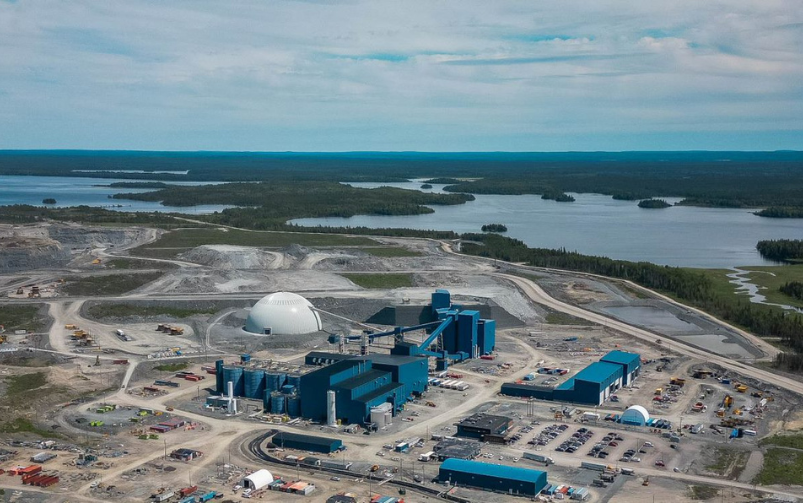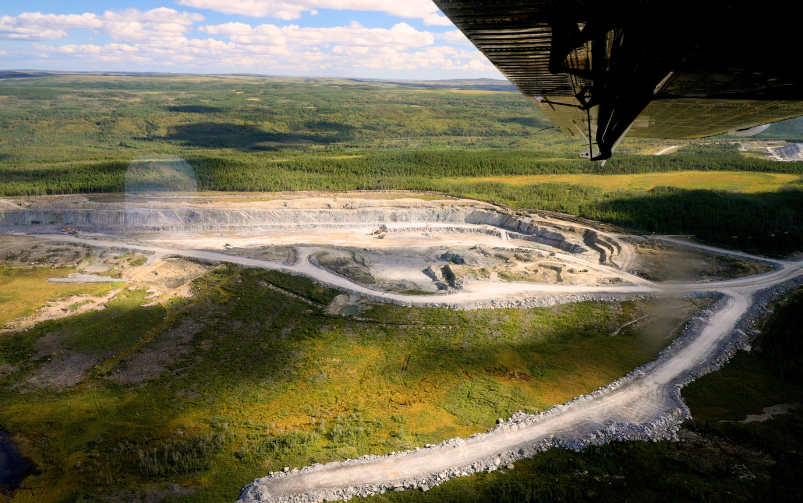(Left to right) Kelly Silva, recruiter for Iamgold, Pamela Osorio Corales, Nikol Cubillos Fernandez, Francisca Puebla Careaga, Heather Gamble, co-founder and CEO of the Artemis Project, Priscilla Navarro, and Anesh Daya, president and founder of On the Spot Language. Courtesy of Artemisa Mining Challenge
Growing up in Chile, Francisca Puebla Careaga heard countless stories from her grandmother about her great-grandfather, who worked as a coal miner in the country his whole life.
“I always say that I have the mines in my veins,” Puebla Careaga said, beaming. Her family lore, coupled with learning about Chile’s history and economy—which were heavily shaped by the mining industry and have been an important part of the Chilean identity—inspired her to study mining engineering at Universidad de Concepción.
However, despite her family history, passion for mining and mining engineering degree, Puebla Careaga struggled to find work in mining engineering after graduating in April 2022, and instead accepted a job as a technical data reporter.
“I was working on a mine site, but in the construction area, developing a ramp in the mine. It was nothing related to [what I studied],” said Puebla Careaga. “I didn’t need to think about drill and blast, [mine planning] or production. It was only shotcrete and stuff that I’ve never learned before. It’s always good to learn something new, but it wasn’t my field.”
Pamela Osorio Corales faced a similar experience. While studying civil mining engineering at Universidad Andrés Bello in Chile—which she graduated from in August 2022—she had trouble securing an internship in her field and settled for one as a trainee engineer in the renewable energy industry instead.
The gender gap
Their situation is common for female mining engineers in Chile. According to a 2013 report from the Intergovernmental Forum on Mining, Minerals, Metals and Sustainable Development, titled “Women and the Mine of the Future,” Chile’s mining industry in 2022 was composed of 10 per cent women, compared to Canada’s 19 per cent in 2021. For Heather Gamble, the co-founder and CEO of the Artemis Project, a program designed to accelerate business outcomes for female entrepreneurs in the mining industry, it was her call to action.
Gamble heard from her company’s Chile chapter that women were encountering hurdles finding work in their field. According to Gamble, despite graduating from top-ranking schools with high academic standings, many female mining engineering graduates in Chile would submit dozens of applications without much luck.
“These women have just graduated and they just kept coming up against a wall,” Gamble said. “Very few of them were even getting interviews. They were taking jobs that had nothing to do with their engineering degrees.”
In response, she co-founded the Artemisa Mining Challenge in 2021 with Helen Krissilas, founder of Krissilas Group, a recruitment firm that specializes in placing women in mining and STEM jobs.
The Artemisa Mining Challenge aims to facilitate Canadian mining companies, which are facing labour shortages and thinning cohorts of mining engineering students, to hire Latin American female mining engineers.
“We all know that there’s a talent crisis going on [in mining] and most mining companies have made steady commitments in terms of raising their levels of diversity because it improves performance,” said Gamble. “[The Artemisa Mining Challenge] is really feeding into that and helping [mining companies] get qualified candidates to begin their careers and foster their development. These young girls tend to look for constant opportunities to learn and grow, so it’s a perfect talent match.”
In June 2024, the Artemisa Mining Challenge launched the 24 by 24 campaign, which aims to boost their current recruitment efforts to hire a total of 24 female mining engineers from Latin American countries by the end of 2024.
Since the Artemisa Mining Challenge was founded, a total of seven women have been successfully hired as mining engineers in training by four mining companies: Puebla Careaga and Osorio Corales were hired by Rio Tinto in January, two were hired by Iamgold, one by New Gold and two more by Eldorado Gold. Gamble said the mining engineers commit to staying in Canada for at least three years once selected by the Artemisa Mining Challenge.
Making the journey
Osorio Corales and Puebla Careaga learned of the Artemisa Mining Challenge through its partner Red Ingenieras de Minas (RIM) Chile, a non-profit organization that promotes women in the country’s mining industry.
Osorio Corales currently splits her time between the Rio Tinto office in Montreal and its smelter in Sorel-Tracy. Meanwhile, Puebla Careaga took a position at the company’s Diavik mine in the Northwest Territories.
Puebla Careaga received the news that she had been selected for the program in January, only two weeks before she needed to hop on a plane and move to Canada. Despite the short notice and with the support of her family, it was easy for her to take the leap.
“I was feeling so frustrated. I felt stuck, like I wasn’t growing up as a professional. It was really depressing,” she said, tearing up. “When Helen asked me if I wanted to participate [in the program], I was working [in construction], [but] it wasn’t my dream job.”
Puebla Careaga said she always wanted to work outside of Chile to meet people from all over the world and experience new cultures, but leaving her grandmother and mother was the downside.
“I’m an only child and I grew up with my grandma and my mom, so I was the spoiled one,” she said. “We’ve never had a lot of resources. I know how difficult it was for my mom to raise me and she had two or three jobs at the same time just to have money and food on our table.”
She added that the experience has been life-changing for her because now she can help her family in Chile.
“I asked [my family], ‘Can I go? Do you want me to go?’ And my grandma was like ‘Yes!’ I thought she was going to say, ‘No, it’s so far away. I don’t want you to leave.’ But I know that they want the best thing for me, and that support gave me the courage that I needed to make this big step in my life,” said Puebla Careaga. “Now, we make video calls every day, but they know that I’m living my best life here.”
Osorio Corales also dreamed of working in mining outside of her home country. She said her mother always pushed her to dream big and, at a young age, she decided she would challenge herself by living outside Chile. Accompanied by her dogs, she said leaving for Canada was easy as she had just graduated, and she did not have family tying her to Chile anymore.
“My mom died two years ago and it was something that she always wanted for me. She always said that someday I’d be living outside of Chile, working in the mining industry. For me, it was like a dream and it was my mom’s dream too,” she said with a tremor in her voice.
Now, five months into their new careers, Osorio Corales and Puebla Careaga are loving their new Canadian environment.
“Everyone has been so welcoming and there’s a lot of women I work with who I look up to. I’m working in the Montreal office so I can meet managers and it’s been really good to learn from them,” said Osorio Corales. “Living here in Montreal, I love it.”
For Puebla Careaga, despite having to acclimate to the colder weather of the Northwest Territories, she is experiencing exactly what she wanted from her career.
“[At Diavik], there are people from Serbia, Nigeria, China, Australia, so it’s a lot of cultures—not only Canadians. So, you understand the point of view of the different realities and that’s awesome,” she said.
Puebla Careaga added that she has loved being able to work with other women and see them in top positions. “Now, we are able to dream about that. Maybe one day, we are going to get to that point,” she said. “That’s inspiring for us.”
Acclimating to a new country
Before they were hired by mining companies, Osorio Corales, Puebla Careaga and two other mining engineers selected for the Artemisa Mining Challenge completed a six-week training program where they lived together in Toronto, went through language and culture training and learned technical terminology.
“It was a really good opportunity to live together, all of us in the house. I made really good friends with them,” Osorio Corales said, noting that their shared experience made the move to Canada easier.
During their stay, they met with Sophie Bergeron, the managing director for iron, titanium and diamonds at Rio Tinto.
As sponsors of the Artemisa Mining Challenge, Rio Tinto and Iamgold fund the training program for the mining engineers and, in return, the companies receive priority when selecting candidates. The candidates were pre-screened by crews from the Artemisa Mining Challenge and RIM Chile and during the training program, Rio Tinto and Iamgold could meet with them to evaluate which candidates were a better fit.
Bergeron hired Puebla Careaga and Osorio Corales and praised their eagerness to learn in their new roles.
“It’s fantastic to see their passion in what they’ve been studying [despite] everything that they’ve been through,” said Bergeron. “They bring a breath of fresh air. It’s refreshing to have access to young women engineers who are so excited to join our Canadian mining industry.”
So far, Rio Tinto has hired Osorio Corales and Puebla Careaga through the Artemisa Mining Challenge, but Bergeron said it is aiming to hire four more before the end of the year.
“Every company is looking for new ways of integrating more diversity and inclusion in their workforce. Artemisa is very innovative and it shows how it’s possible when you want to make it happen. When people are saying that diversity is difficult to [achieve], I think about Artemisa,” said Bergeron.
Kelly Silva, senior manager of global talent acquisition at Iamgold, stated in an email to CIM Magazine that she was moved by the dedication and the courage of the women selected for the program.
“Their story is a reminder that passion knows no boundaries and that the pursuit of knowledge and growth is a universal language that unites us all. I am deeply grateful for the opportunity to share in this uplifting experience and look forward to following their careers,” she wrote, noting that Iamgold’s two new hires, Nikol Cubillos Fernandez and Priscilla Navarro, who work as mining engineers in training at its Côté Gold mine in Ontario, are “a welcome addition to Iamgold.”
Iamgold is also considering hiring more women through the Artemisa Mining Challenge.
Currently, Artemisa needs to facilitate the hiring of 17 more women by the end of the year to achieve its 24 by 24 goal. Gamble said the organization has pre-screened multiple candidates and received applications from many more, all of whom inspire her.
“I hope that they know how incredible they are, to take that kind of adventure away from your homeland and go to remote areas—as we know mining is—and just figure it out, commit and do your best. It’s amazing. They’re great role models,” said Gamble.
How to apply
Candidates can apply to the Artemisa Mining Challenge through its website or its partner association Red Ingenieras de Minas (RIM) Chile.
Candidates must have:
» a valid passport;
» a mining, geology, metallurgy or mechanical engineering degree;
» six months of practical experience in their field;
» a driver’s licence or in progress; and
» at least two doses of a COVID-19 vaccine.
Candidates initially enter the country on a visitor visa and obtain a work permit once they are hired by a mining company.




